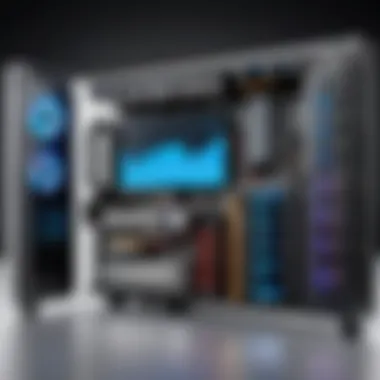The Ultimate Guide to the Best Gaming Computer of 2023


Intro
In the rapidly evolving world of gaming, technology is never stagnant. Understanding what defines the 'number one' gaming computer requires a nuanced analysis of technical advancements, component specifications, and performance metrics. This guide aspires to outline each important element that collectively contributes to unrivaled gaming experiences. For tech enthusiasts and industry professionals, grasping such criteria is vital for making informed purchasing decisions.
Tech Trend Analysis
Overview of the current trend
Currently, the gaming computer landscape is characterized by a fast pace of development in hardware and optimizations that cater to realistic and immersive gaming experiences. High-refresh-rate monitors, advanced graphics processing units (GPUs), and solid-state drives (SSDs) have become industry standards. Players demand systems that offer not only high frame rates but also impressive load times. As a result, manufacturers continuously unveil systems equipped with cutting-edge GPUs like NVIDIA’s GeForce RTX or AMD's Radeon series that harness ray tracing for realistic lighting.
Implications for consumers
These developments often lead to confused consumers, especially when they are bombarded with options. Determining what product is indeed the best for gaming can overwhelm anyone. However, understanding value relative to performance can ease this decision-making process. When consumers have access to better-performing components, they are likely to select a gaming computer that enhances their overall gaming enjoyment.
Future predictions and possibilities
In the future, as VR gaming becomes more widespread, we can expect an even more significant shift in gaming computers. With companies investing heavily in immersive technology, new products will likely feature components specifically tailored for virtual and augmented reality scenarios. Improved thermal management solutions, longer battery life in portable systems, and AI-driven optimizations could make significant headlines in coming years. As adoption increases, so too do expectations and standards among consumers.
Product Reviews
Overview of the product
Several gaming computers stand out currently in the market. Amidst so much variety, specific models cycle through noticeable variations in performance and overall value, defining their standing as 'number one.' A prime example of such a model arises from Alienware, known for a unique balance between excellent performance and design aesthetics.
Features and specifications
The notable specifications include:
- Intel Core i9 or AMD Ryzen 9, ensuring phenomenal gaming performance.
- At least 32GB of RAM for smooth multitasking during intense gaming sessions.
- NVIDIA GeForce RTX 4080 to leverage real-time ray tracing.
- 1TB NVMe SSD accelerating load times and data transfer rates.
Performance analysis
From user feedback and benchmarks, gaming performance translates into higher frame rates across demanding titles. Players have reported substantial reductions in load times when using NVMe drives, enhancing overall gameplay flow. Benchmarks confirm frame rate stability, reaching above 60 FPS even in graphically intensive scenes, painting a clear picture of real-world operation.
Pros and cons
Understanding both the strengths and limitations will provide clarity:
Pros:
- Exceptional build quality and aesthetics.
- High adaptabiliy to future upgrades.
- Strong community support and warranty options.
Cons:
- High price range.
- Weightier than alternative desktop setups.
Recommendation
Taking into account the evaluations, the Alienware X15 stands out as a recommendable choice for gamers seeking top-notch configurations. However, individualized needs should also guide the decision; a tailored approach ensures the best suit for personalized gaming habits, budget, and play styles.
How-To Guides
Preface to the topic
Choosing the right gaming computer requires an understanding of technical and performance specifications. Yet considerations extend beyond the specs to gaming preferences prioritizing, say, portability over raw power.
Step-by-step instructions
- Assess gaming needs, focusing on game genres and expected performance requirements.
- Define the budget. Ensure balance between performance, component types, and cost.
- Compare models being looked into by diving into specifications and existing user reviews.
- Verify the warranty and customer support.
Tips and tricks
- Experiment with adjustable graphic settings in different games to find processor limits without compromising aesthetics drastically.
- Keep your operating systems updated to enjoy optimal security and performance.
Troubleshooting


Issues may arise in setup or during gameplay, such as screen tearing and overheating. For basic troubleshooting:
- Make sure drivers are always up to date with reliable manufacturers.
- Monitor temperatures using tools such as HWMonitor to detect potential overheating problems.
Industry Updates
Recent developments in the tech industry
With NVIDIA’s recent launch of its latest GPU range creating waves, various gaming companies such as MSI and ASUS are updating their hardware systems adaptively. Each new release denotes a race not only in graphical fidelity but also in VR readiness.
Analysis of market trends
The market shifts towards power efficiency resonates well with expectations for user experience improvements, which condensed down informs tangible choices by consumers seeking cost-effective configurations.
Impact on businesses and consumers
These trends project so much progress on both sales targets for manufacturers and improved accessibility to robust performance for consumers. Growing user sophistication in claims allows gamers to synthesize choices towards more fulfilling outcomes in their gaming pursuits.
Prelude to Gaming Computers
Gaming computers have revolutionized the way enthusiasts engage with interactive entertainment. They serve not merely as consoles or standard PCs; instead, they provide a dedicated environment to experience and immerse oneself in richly detailed worlds. The rise of gaming culture has brought a demand for high-performance systems capable of meeting the rigorous demands of modern games and user expectations.
Defining a Gaming Computer
A gaming computer can be defined as a specialized computing system designed to handle the complexities of high-definition video games. This definition, while straightforward, encompasses certain key aspects. First, these systems typically possess high-speed processors that can execute instructions rapidly, driving smooth gameplay across demanding titles. Second, superior graphics cards are essential, as they render vivid visuals and intricate details that enhance the gaming experience. Lastly, adequate memory is crucial not only for processing during gameplay but also for multitasking and running additional applications while gaming, such as streaming software or communication tools.
When people think of gaming computers, they often imagine powerful desktops. However, it is worth noting that modern laptops can also offer impressive gaming capabilities. These portable systems combine high-grade components with mobility, though they might face challenges with thermal throttling and weight.
The Evolution of Gaming Computers
The journey of gaming computers mirrors advancements in technology itself. Initially, gaming machines were simple, designed for basic graphics and gameplay. These early systems, primarily seen in the 1980s and 1990s, had limited hardware capabilities and often struggled with graphical fidelity and speed. Eventutally, these limitations propelled manufacturers to enhance their components and systems dramatically.
With the introduction of more powerful processors and graphics cards throughout the years, gaming computers became able to support increasingly complex graphics and gameplay mechanics. The early 2000s marked a significant change; gaming experienced a notable upgrade with powerful GPUs released by companies like NVIDIA and ATI (now AMD). These developments facilitated a major leap in visual quality and performance.
The trend continues today. Continuous innovations in hardware—from the release of multi-core CPUs to solid-state drives—have further augmented gaming performance. As technology shifts towards AI-assisted functionalities, one can anticipate that the trajectory of gaming computers will continue its upward momentum, blending unparalleled graphics with enhanced processing capabilities. This evolution points to fundamental changes in both consumer expectations and gameplay experiences.
"The definition of a gaming computer is fluid, adapting seamlessly to technological advancements and evolving player needs. What was cutting-edge yesterday may simply be the baseline today."
Understanding the landscape of gaming computers is paramount for discerning gamers and industry professionals. As we delve deeper into key components and performance metrics, the significance of choosing the right system aligns closely with the advancements shaping our future gaming experience.
Key Components of a Gaming Computer
Understanding the key components of a gaming computer is crucial. These elements not only affect the overall performance and gaming experience but also dictate upgrade paths and longevity of the device. Each component serves a distinct function, directly contributing to how smoothly a game runs and the quality of the visuals it can display.
Processor: The Heart of Gaming Performance
The processor, often seen as the brain of a gaming computer, plays a significant role in determining its performance. Modern gaming requires substantial processing power. A capable CPU can manage various tasks from simple input operations to complex calculations required for graphical rendering. Players need to consider chip speed and core count carefully. Popular choices include Intel Core i7 and AMD Ryzen 7. They provide a balanced performance for both gaming and multitasking.
Graphics Card: Rendering the Game World
The graphics card is perhaps the most vital component in terms of visual performance. It determines how detailed and smooth the game graphics are presented. There are leading players in this realm such as NVIDIA and AMD. Features like ray tracing and enhanced frame rates are vital for contemporary games and realist graphics.
Choosing the right graphics card requires assessing the gaming resolution and types of games played. For instance, cards like the NVIDIA RTX 3080 or the AMD Radeon RX 6800 XT deliver exceptional results. Without adequate graphical power, the experience can feel heavy and clumsy.
Memory and Storage: Speed and Capacity
Memory, better known as RAM, is essential for game performance and speed. Higher RAM allows for improved loading times and better multitasking. Typically, 16GB is the current standard for gaming computers. When it comes to storage, Solid State Drives (SSDs) stand out because of their faster data retrieval speeds. This can reduce game load times significantly.
Mechanical Hard Drives (HDDs) still serve as bulk storage. Combining the two can optimize your setup. The ideal blend allows for fast game loading and impressive storage for numerous titles.
Motherboard: The Backbone of the System
The motherboard connects all these components. It determines basic compatibility, upgrade potential, and features like Wi-Fi and overclocking abilities. Various brands like ASUS and MSI offer choices catered towards gamers. It’s important to check factors like PCIe slots for future upgrades, as well as supported RAM types when selecting a motherboard.
Cooling Solutions: Maintaining Optimal Performance


Cooling is often overlooked but plays a vital role in maintaining system health. High-end components generate considerable heat, which, if not managed properly, can cause throttling or hardware damage. There are several cooling methods available ranging from air cooling systems to liquid cooling solutions.
For instance, products from Cooler Master provide reliable air cooling, while Corsair’s liquid cooling systems have proven particularly effective for gamers seeking quiet and efficient cooling. Maintaining a temperature range is crucial for peak performance, ensuring everything runs smoothly during extended gaming sessions.
Proper thermal management is essential for performance longevity in a gaming computer.
Evaluating Gaming Performance Metrics
Evaluating gaming performance metrics is crucial in understanding how a gaming computer truly performs under different conditions. It informs potential buyers about what to expect in terms of playability and visual fidelity. In gaming, specific measures such as frame rates, resolution, and latency are essential metrics that help to ascertain a system’s capability. Knowing these metrics aids in making informed decisions. Tech enthusiasts and industry professionals alike can strategically gauge their specific needs based on these performance indicators.
Frame Rates: Understanding Gameplay Smoothness
Frame rates play a vital role in assessing gameplay fluidity. Measured in frames per second (FPS), higher frame rates correspond to smoother visuals. Common standards include 30 FPS for console gaming and 60 FPS for high-performance PCs. A frame rate above 60 gives an edge in terms of responsiveness and immersion, essential for competitive gaming.
- 30 FPS: Acceptable for casual gaming or slower games.
- 60 FPS: Recommended for most games for a good balance.
- 144 FPS and above: Offers a significant advantage in competitive scenarios.
When some experience lower frame rates on modern software, others delight in higher rates, especially with high-refresh displays. The difference in experience is palpable. Lower FPS can cause stuttering and tearing, severely impacting gameplay, primarily if the player is competitively twisted. Therefore, a robust graphics card combined with adequate cooling can help maintain consistent frame rates.
Resolution and Visual Quality
Resolution refers to the amount of detail in a game's visuals. Common screen resolutions include 1920 x 1080 (Full HD), 2560 x 1440 (QHD), and 3840 x 2160 (4K). High-resolution visuals enhance detail, making characters and environments incredibly realistic. However, higher resolutions demand more from a graphics card.
Some key points regarding resolution:
- Full HD (1080p): Still the most common resolution, balancing performance and quality.
- QHD (1440p): Gaining popularity; provides a notable visual increase without doubling the hardware specs.
- 4K (2160p): Dramatic detail; requires high-end graphics solutions.
An interesting aspect for gamers to consider is the balance between frame rate and resolution. A system that delivers 144 FPS at 1440p can typically offer a sharper visual treat.
Latency: The Importance of Response Time
Latency is another key performance metric that refers to the delay between the player performing an action and the system responding. A high latency can lead to unfair disadvantages in fast-paced gaming scenarios. Various factors influence latency
Some general categories to consider include:
- Ping Rate: The response time between the player's computer and the game server; essential for online multiplayer games.
- Input Lag: Refers to the delay between pressing a button and seeing the action on-screen. This should ideally be minimal.
- Frame Delay: Any additional frames lost throughout your graphics processing can affect overall experience.
Understanding and monitoring latency allows gamers to ensure a responsive experience. Regular checks of each gaming system's readings against standards in gaming, provide great awareness. Shooter games, in particular, demand low latency to maximize gameplay effectiveness. Thus, being conscious of how latency affects performance metrics may also result in more strategic gameplay decisions, enhancing competitiveness.
Top Gaming Computer Brands
Choosing the right brand is essential when discussing gaming computers. The brand affects reliability, performance, and support service. Several manufacturers stand out for their dedication to high-quality gaming solutions. The leading ones include Alienware, ASUS ROG, and MSI. This selection considers not just performance but also aesthetics and customer service. Understanding each brand's strengths helps buyers make much better choices aligned to their gaming needs.
Alienware: The Premium Choice
Alienware has long been synonymous with high-end gaming experiences. Dell’s premium gaming line focuses on solid build quality as well as powerful hardware. The designs are not only sleek, but they also offer customization options tailored to different players. A core strength of Alienware is its superior cooling systems.
Many gamers praise Alienware computers for their beauty and functionality.
- Feature robust graphics cards like the NVIDIA GeForce series.
- Offer processors optimized for intense gaming sessions.
- Have upgrade paths for both CPU and GPU.
Solid customer support adds to their value, ensuring gamers get established help when needed.
ASUS ROG: A Gamer’s Dream
ASUS Republic of Gamers (ROG) line presents machines tailored to the serious gamer. ROG has developed a reputation for high-performance gaming laptops and desktops packed with essential features. Their hardware often includes components optimized for upgradability and engineering aimed to minimize lag.
Some appealing specifics about ASUS ROG include:
- Innovative cooling technology aiming to keep performance steady during long sessions.
- Monitor support often includes high-refresh-rate options perfect for gaming enjoyment.
- Customizable RGB lighting settings enhance the visual experience.
Historically, gamers in various competitive circuits have chosen ASUS ROG products for their reliability and performance.
MSI: Balancing Performance and Style
MSI is another noteworthy contender in the gaming computer market known for balancing functionality and aesthetics. Their designs appeal to gamers who want high performance packaged in visually interesting configurations. This company offers gaming computers with high refresh rates and powerful performance.


Key highlights of MSI gaming computers include:
- Proven performance ratios by utilizing top-tier graphics cards and CPUs.
- Excellent build quality with durable materials showing investment durability.
- A strong focus on stereo sound support adds to the gaming experience.
Ultimately, MSI has earned a reputation not only for meeting performance demands but also for enhancing the overall style of any gaming environment.
The competition among top gaming brands encourages manufacturers to innovate continually, delivering cutting-edge technologies to the gaming community.
Building vs.
Buying Pre-Built Gaming Computers
In the ever-evolving landscape of technology, choosing between building a gaming computer and buying a pre-built one is a significant decision for tech enthusiasts. This section aims to dissect both options, outlining their key advantages and downsides. Understanding these elements is crucial for selecting the best path in enhancing gaming experience, performance, and satisfaction.
Pros and Cons of Building Your Own
Building your own gaming computer can be appealing due to several factors. Here are some benefits:
- Customization: You have control over every component, allowing you to select parts that fit your exact preferences and performance needs. This ensures the system is tailored perfectly for your gaming style and requirements.
- Cost Efficiency: Typically, building your own PC can be more cost-effective. You avoid markup costs associated with assembly and brand labeling, enabling better allocation of funds towards high-performance parts.
- Better Quality Control: As the builder, you can choose reputable brands for each component. This can strengthen the build quality and longevity of the system compared to many mass-produced machines.
However, there are notable disadvantages:
- Time-Consuming: The process requires considerable investment in time, from research to assembly. For someone without experience, overcoming initial challenges might be frustrating.
- Technical Know-How: Knowledge of computer hardware assembly and compatibility is essential. Missteps can lead to system failures.
Advantages of Pre-Built Options
Buying a pre-built gaming computer offers different kinds of benefits:
- Ease of Use: Pre-built systems allow for immediate usage. The buyer can begin gaming without the hurdles related to assembly. This is especially beneficial for users who prioritize a straightforward purchasing process.
- Reliable Support: Often, manufacturers provide warranties and customer support. This can ease mind for individuals unwilling to troubleshoot or fix problems on their own.
- Optimization: Many brands invest in performance optimization during assembly, ensuring that all components work seamlessly together.
Conversely, some downsides include:
- Limited Customization: Pre-built models often come with fixed specifications. Customization options may be limited or non-existent.
- Higher Cost: Selection tends to come with a premium. The price point might be higher than building a comparable system due to additional labour and warranty inclusion.
Choosing between building or buying usually boils down to personal preference and confidence in technical skills. Both options can offer respectable gaming performance but understanding their pros and cons can lead to a more satisfying decision.
The Future of Gaming Computers
The realm of gaming computers is poised for profound transformation in the coming years. This section delves into key elements that will define the future landscape in the gaming industry. The emphasis will be on upcoming technologies and the influence of artificial intelligence, among other facets.
Upcoming Technologies in Gaming Hardware
In gaming hardware, innovation never ceases. Future gaming computers are likely to feature component advancements that significantly alter gameplay. Some notable technologies include:
- Ray Tracing: This technology is already emerging but will become commonplace in consumer-level hardware. Ray tracing mimics the real-world behaviors of light, which results in stunning graphics and incredible realism in games.
- New Graphics Cards Architectures: Major players like NVIDIA and AMD continue to release new generations, bringing enhancements in performance and energy efficiency. Expect more powerful GPUs that can handle increasingly demanding game environments.
- Faster Storage Solutions: Solid State Drives will only get faster and more cost-effective, improving loading times and overall responsiveness of games and applications.
- Enhanced Processors: The rise of multi-core processors designed for gaming will help push limits beyond current norms, thus ensuring a smoother experience.
Each of these technologies holds immense potential to elevate gaming experiences, making them smoother, more immersive, and ultimately more enjoyable.
The Role of Artificial Intelligence
Artificial intelligence will greatly impact gaming computers and the gaming industry in general. As developers aim for more realistic gaming landscapes and enemy behaviors, AI will serve multiple purposes:
- Dynamic Difficulty Adjustment: AI can analyze player performance and adjust difficulty levels in real time, ensuring a balanced challenge.
- Procedural Content Generation: AI can generate game environments and other content dynamically, making every gameplay experience unique.
- Enhanced NPC Behavior: The utilization of machine learning can lead to non-playable characters with more advanced and realistic behaviors, creating a richer gaming landscape.
As noted in industry reports, the integration of AI is expected to set a new standard in gaming experiences, providing players with far more engaging contents than ever before.
The combination of innovative hardware and artificial intelligence reflects a compelling future for gaming computers, enhancing the gameplay and taking the immersive experience to returning heights. Embracing these trend points enables gamers to stay ahead and ensures access to the latest developments that shape the digital entertainment landscape.
The End: Choosing the Right Gaming Computer
Choosing the right gaming computer is a pivotal decision for anyone looking to elevate their gaming experience. With vast advancements in technology, understanding personal gaming needs is both an art and a science. A well-prepared assessment of how you play games can direct you toward the components necessary to enhance performance.
Beyond just brand preferences, attention must be given to hardware specifications, budget, and intended use. Each gamer celebrates different playing styles: some enjoy high-intensity first-person shooters while others may prefer immersive expansive role-playing experiences. Recognizing your preferences will ultimately help guide several meticulous considerations in selection.
Assessing Personal Gaming Needs
When assessing personal gaming needs, you should carefully consider what type of games you play. For instance, if you prioritize frame rates and fast responses, significant investment in high-performance hardware becomes necessary. Is it the graphics you seek to impress you visually, or do you require extensive multitasking? Answering these questions sharpens your focus on what components support your plans.
Secondly, budgetary constraints determine what can be realistically purchased; knowing what important features provide more significant advantages can be quite advantageous. Different gaming experiences demand differing hardware capabilities. Hence, creating a gaming profile based on your gaming habits can provide tangible insights while navigating the multitude of products on the market. Analyzing a range of gaming styles narrows potential builds or purchases significantly.
*“Identifying your gaming needs is not merely about picking up what's trendy; it involves extensive consideration into both today’s requirements and tomorrow’s advancements.



